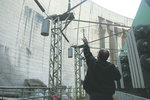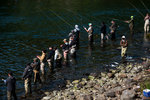

Editor’s Note: The following is the second part of a two-part series focused on the effects of Cowlitz River dams on wild fish populations. See the Journey on the Cowlitz special edition inside.
In the face of criticism over lackluster wild salmon runs, Mark LaRiviere, senior fisheries biologist for Tacoma Power, says the utility is meeting the agreed-upon obligations to create fishing opportunities in the Cowlitz River Basin.
LaRiviere pointed out that the current settlement agreement and the 2011 Cowlitz Fisheries and Hatchery Management Plan Update calls for Tacoma Power “to recover listed anadromous fish populations to harvestable, self-sustaining levels” as part of its ongoing responsibilities for mitigating the Mossyrock and Mayfield dams.
Tacoma Power statistics show that over the last decade the average annual return of salmon and steelhead has been 95,509 fish, or as LaRiviere put it, “probably about the same,” as historical pre-dam levels.
The difference is that because of the dams, 90 percent of today’s fish are of hatchery origin. The remaining 10 percent are considered “natural-origin,” which includes, but is not limited to, wild fish. Natural origin simply means the fish originated from gravel, so they could have been spawned by one or more hatchery fish.
“The point I often make,” explained LaRiviere, “is that the dams did not destroy the runs of salmon and steelhead in the Cowlitz River, but they did fundamentally change them, from self-sustaining, natural-origin populations to hatchery populations.”
Hatchery populations require a lot of investment. The quantity of smolt that must be produced from the hatcheries in order to keep the runs going is staggering.
Salmonids typically spend between four and seven years out at sea before they return to their rivers of origin. The uncertainties of that journey make returning fish numbers difficult to project, let alone control. As a result, the strength of yearly fishing runs tends to be cyclical. A spawning salmon has successfully migrated to the sea, avoided untold numbers of predators, including birds, bigger fish, whales and sea lions, then managed to evade the ocean charter boats, the nets of commercial and tribal fishermen and a gauntlet of anglers lining riverbanks.
According to LaRiviere, the ratio of smolt-to-adult returns (SAR’s), “is foremost in our hatchery operations planning. We have adjusted the genetic composition of the hatchery stocks, their growth rates in the hatchery, we have challenged them with predators, and we have adjusted both the time of release and size at release to increase the SARs.”
Those SARs, despite Tacoma Power’s efforts, are low. The recent 5-year average of SARs for hatchery smolt are just 0.2 percent for fall chinook, 0.9 percent for spring chinook, 2.7 percent for coho, 1 percent for winter steelhead, 1.6 percent for summer steelhead and 1.1 percent for sea-run cutthroat.
No Bite, No Fighting Fish
While the agencies are focused on the quantity of fish in the river, anglers complain about quality.
They’re concerned that the fitness of the hatchery fish is lacking compared to wild fish and may be a factor in the dismal return rates. Secondly, the consensus in the fishing community is hatchery fish are not aggressive enough to be fun for sport fishing. The lack of aggression, they think, comes from their domesticated origins where they stare at hatchery workers and wait for food to fall from the sky.
Anglers who hook hatchery fish often say there is a telltale lack of fight compared to wild fish that aggressively tug, run, and breach the water to be freed. In comparison, hatchery fish feel like reeling in a piece of driftwood against the current.
A popular, but unsubstantiated, fisherman theory claims the most aggressive fish have been culled from the hatchery ranks since they were the ones that wanted to bite.
The less aggressive fish then became the ones that return to the hatchery to be used as breeding stock. That cycle, played out over many decades, has left a hatchery gene pool chalk full of passive fish that are unconcerned with natural behaviors like feeding or lingering in the river system.
Some fishermen also say low and slow river flows, caused by the dams and exacerbated by drought and low snowpack only make it worse. Interestingly, the lack of downriver flow seems to inspire the hatchery fish to simply jet upstream as they are unimpeded by the force of the river on their way to the hatchery for collection.
As one Cowlitz fisherman, who preferred to remain anonymous due to the highly contentious nature of fish issues on the Cowlitz, said, “The fish just move through the river so fast they’re hard to catch them and then the people at the dam are like, ‘Look at how many fish just came back!’”
Reduce, Reuse, Recycle
In order to combat those fast track returners the WDFW has for years been running a recycling program for summer steelhead. The fish are collected at the hatchery and then trucked back down river in order to give anglers a second chance to hook them. But in recent years there has been growing sentiment among wild fish advocacy groups and the National Marine Fisheries Service that the presence of hatchery fish in the river is contributing to the low numbers of wild fish. As a result the recycle program has come under fire and cuts have already been made to the effort.
This year 6,000 was the original proposal for recycled summer steelhead on the Cowlitz. At a public meeting in late spring however that number was dropped to 3,330 fish. Bob Reid maintains that the recycle cuts were enacted “for no good reason,” and that the WDFW simply chose to go with the “safer” number.
Reid said, “There’s been four separate studies that have shown that recycled strays,” hatchery fish that wander into unintended spawning grounds, “are not a problem.”
According to LaRiviere, there are no other plans in the works to make a heartier stock of hatchery smolt. By his telling, Tacoma Power, in conjunction with the WDFW, will simply, “continue to produce hatchery fish and to make them available for harvest in many locations, at many times.” He describes those efforts as, “following the desires of sport fishing advocacy groups.”
Dams: What Goes Up ...
The only serious way to restore wild runs would be to remove the dams. As crazy may sound, removing dams in the name of wild fish has happened in Washington.
In the recently undammed Elwha and White Salmon rivers the return of wild fish was seen earlier and further into the headwaters than most experts predicted.
But undamming the Cowlitz doesn’t seem to be an option.
LaRiviere stated flatly that undamming the Cowlitz is, “not plausible,” and that the dams could be structurally sound for at least another 150 years.
“There is a demand and need for electricity in today’s society. The alternatives for supplying power to a growing population in the Pacific Northwest are generally more polluting, more expensive and come at their own environmental costs,” he said.
Bill Iyall, from the Cowlitz Tribe, has a mixed opinion.
“I believe that all rivers should be free,” Iyall said, but he readily admits that a free-flowing Cowlitz is a longshot at best but hopes for a solution.
“The best thing people can do now is work together to restore those stocks to the largest numbers possible under the current conditions,” he said.
For its part, the tribe is working to rehabilitate fish habitat in the lower and upper Cowlitz in order to create more spawning opportunities for wild fish.
“We have to be able to restore that habitat so that in future members will have access to the same resources that have (historically) provided for our people.” he said. “To whatever degree the salmon recover, I think traditional fishing practices should be supported by the greater community because that is how we support our greater community.”
Reid agreed that the current unnatural state of fishing affairs is far from ideal. He said CPR is even opposed to trucking fish. “But if they’re allowed to do that, then that’s what Tacoma Power is going to do,” said Reid. “Trucking fish is a lot cheaper than creating fish passages.”
Reid added, “It’s the reality of what we have. People aren’t going to get rid of the dams, so you take what you can get.”
•••
Jordan Nailon is a freelance journalist and Outdoors writer for The Chronicle. See the first part of this story at www.chronline.com or cowlitz.seesouthwestwa.com.